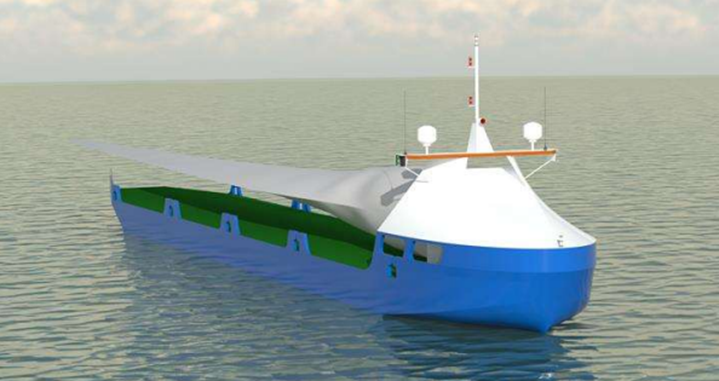SPINE 2 project concludes with recommendations for a fully electric Remotely Operated Uncrewed Vessel

Phase 1 of the SPINE project, (Shipping and Port Interfaces in the New Era) advanced the automation of operations in the land/water interface, supporting both infrastructure and operations in the port environment. More information about its achievements and findings can be found here.
Towards the end of SPINE Phase 1 activities, it was agreed with the funders, MarRI-UK to use the remaining unspent budget to deliver a concept design which would demonstrate the value of the SPINE achievements in a real operational scenario. This scenario is based on the operation of a vessel which transfers wind turbine blades from a factory in Cowes to other areas of the Solent.
The goal of SPINE 2 was to demonstrate how SPINE advances could be exploited in a real-life deployment of a zero-emission, ROUV (Remotely Operated Uncrewed Vessel). SPINE 2 has performed front-end engineering studies to investigate how the current conventional diesel-propelled, near-shore freighter with a crew of four, could be replaced by an all-electric, de-crewed vessel.
The concept for the vessel assumed electric propulsion using shoreside recharging which significantly reduces the carbon footprint of the vessel operation. The design was found to have an acceptable level of navigational risk while operating in congested waters such as the Solent. The navigational risk was assessed using the IALA Waterway Risk Assessment Programme (IWRAP).

Artists impression of the vessel. Copyright Houlder Ltd
The SPINE 2 phase of the project has delivered a robust evidence base and confirmed the technical feasibility of developing and operating a remotely operated, all-electric, uncrewed vessel for transporting freight within the Solent.
The 'next steps' indentified by the project would be:
- Commission a full engineering study to mature the concept to detailed design readiness, to include structural, electrical and systems integration, design the autonomous control system, detail the size and layout of the battery energy storage and propulsion system and optimise the berth-side charging systems and electrical infrastructure.
- Prototype and test the navifation and control systems
- Confirm regulatory and safety requirement
- Refine the navigational risk assessment
- Develop a scalable recharging infrastructure plan
- Prepare an investment case for a demonstrator phase
The technical, operational, and commercial challenges have been well characterised within the SPINE projects, and no insurmountable barriers have been identified. With targeted investment and continued collaboration across regulatory, port, and industry stakeholders, the project concludes that the UK is well-positioned to lead the deployment of one of the first operationally viable, remotely operated electric cargo vessels in northern European waters - regardless of the final vessel chosen for demonstration.
For more information click here.
Project partners for SPINE 2 have included MSE International, Swanbarton, Houlder and Marico Marine.
SPINE is being supported by MarRI-UK as part of the Smart Maritime Land Operations Call.


